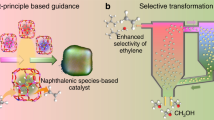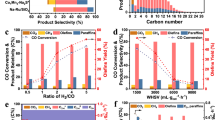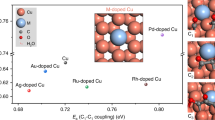Abstract
Mitigating catalyst deactivation in the industrially deployed process of methanol-to-olefins conversion over HSAPO-34 is a critical challenge. Here, we demonstrate that lifetime in methanol-to-olefins catalysis over HSAPO-34 at sub-complete methanol conversion, as determined by the cumulative turnover capacity per Brønsted acid site towards hydrocarbon products in the effluent before complete catalyst deactivation (~15% carbon final conversion), can be enhanced with increasing efficacy (~2.8× to >70×) by co-feeding H2 at increasing partial pressures (400–3,000 kPa) in the influent with methanol compared with co-feeding helium at equivalent pressures. The lifetime improvement in the presence of high-pressure H2 co-feeds is observed to be more prominent at complete methanol conversion than at sub-complete conversion. The improvements in catalyst lifetime by co-feeding H2 are rendered without any deleterious effects on C2–C4 olefins selectivity, which remains ~85% carbon irrespective of the inlet H2 pressure. These observations can be rationalized based on the participation of H2 in hydrogen transfer reactions, and in effect, the interception of pathways that promote the formation of deactivation-inducing polycyclic species.
This is a preview of subscription content, access via your institution
Access options
Access Nature and 54 other Nature Portfolio journals
Get Nature+, our best-value online-access subscription
$29.99 / 30 days
cancel any time
Subscribe to this journal
Receive 12 digital issues and online access to articles
$119.00 per year
only $9.92 per issue
Buy this article
- Purchase on Springer Link
- Instant access to full article PDF
Prices may be subject to local taxes which are calculated during checkout




Similar content being viewed by others
Data availability
The data that support the plots within this paper and other findings of this study are available from the corresponding author upon reasonable request.
References
Chen, J. Q., Bozzano, A., Glover, B., Fuglerud, T. & Kvisle, S. Recent advancements in ethylene and propylene production using the UOP/Hydro MTO process. Catal. Today 106, 103–107 (2005).
Mokrani, T. & Scurrell, M. Gas conversion to liquid fuels and chemicals: the methanol route-catalysis and processes development. Catal. Rev. 51, 1–145 (2009).
Yilmaz, B. & Müller, U. Catalytic applications of zeolites in chemical industry. Top. Catal. 52, 888–895 (2009).
Tian, P., Wei, Y., Ye, M. & Liu, Z. Methanol to olefins (MTO): from fundamentals to commercialization. ACS Catal. 5, 1922–1938 (2015).
Baerlocher, C., McCusker, L. B. & Olson, D. Atlas of Zeolite Framework Types (Elsevier, Amsterdam, 2007).
Song, W., Haw, J. F., Nicholas, J. B. & Heneghan, C. S. Methylbenzenes are the organic reaction centers for methanol-to-olefin catalysis on HSAPO-34. J. Am. Chem. Soc. 122, 10726–10727 (2000).
Song, W., Fu, H. & Haw, J. F. Supramolecular origins of product selectivity for methanol-to-olefin catalysis on HSAPO-34. J. Am. Chem. Soc. 123, 4749–4754 (2001).
Arstad, B. & Kolboe, S. Methanol-to-hydrocarbons reaction over SAPO-34. Molecules confined in the catalyst cavities at short time on stream. Catal. Lett. 71, 209–212 (2001).
Arstad, B. & Kolboe, S. The reactivity of molecules trapped within the SAPO-34 cavities in the methanol-to-hydrocarbons reaction. J. Am. Chem. Soc. 123, 8137–8138 (2001).
Song, W., Marcus, D. M., Fu, H., Ehresmann, J. O. & Haw, J. F. An oft-studied reaction that may never have been: direct catalytic conversion of methanol or dimethyl ether to hydrocarbons on the solid acids HZSM-5 or HSAPO-34. J. Am. Chem. Soc. 124, 3844–3845 (2002).
Nawaz, S., Kvisle, S., Lillerud, K.-P., Stocker, M. & Øren, H. Selectivity and deactivation profiles of zeolite type materials in the MTO process. Stud. Surf. Sci. Catal. 61, 421–427 (1991).
Yuen, L.-T., Zones, S. I., Harris, T. V., Gallegos, E. J. & Auroux, A. Product selectivity in methanol to hydrocarbon conversion for isostructural compositions of AFI and CHA molecular sieves. Microporous Mater. 2, 105–117 (1994).
Haw, J. F., Song, W., Marcus, D. M. & Nicholas, J. B. The mechanism of methanol to hydrocarbon catalysis. Acc. Chem. Res. 36, 317–326 (2003).
Schulz, H. “Coking” of zeolites during methanol conversion: basic reactions of the MTO-, MTP- and MTG processes. Catal. Today 154, 183–194 (2010).
Olsbye, U. et al. Conversion of methanol to hydrocarbons: how zeolite cavity and pore size controls product selectivity. Angew. Chemie Int. Ed. 51, 5810–5831 (2012).
Marcus, D. M. et al. Experimental evidence from H/D exchange studies for the failure of direct C–C coupling mechanisms in the methanol-to-olefin process catalyzed by HSAPO-34. Angew. Chemie Int. Ed. 45, 3133–3136 (2006).
Müller, S. et al. Hydrogen transfer pathways during zeolite catalyzed methanol conversion to hydrocarbons. J. Am. Chem. Soc. 138, 15994–16003 (2016).
Martinez-Espin, J. S. et al. New insights into catalyst deactivation and product distribution of zeolites in the methanol-to-hydrocarbons (MTH) reaction with methanol and dimethyl ether feeds. Catal. Sci. Technol. 6, 2314–2331 (2017).
Hwang, A., Kumar, M., Rimer, J. D. & Bhan, A. Implications of methanol disproportionation on catalyst lifetime for methanol-to-olefins conversion by HSSZ-13. J. Catal. 346, 154–160 (2017).
Martinez-Espin, J. S. et al. Hydrogen transfer versus methylation: on the genesis of aromatics formation in the methanol-to-hydrocarbons reaction over H-ZSM-5. ACS Catal. 7, 5773–5780 (2017).
Arora, S. S. & Bhan, A. The critical role of methanol pressure in controlling its transfer dehydrogenation and the corresponding effect on propylene-to-ethylene ratio during methanol-to-hydrocarbons catalysis on H-ZSM-5. J. Catal. 356, 300–306 (2017).
Meusinger, J. & Corma, A. Activation of hydrogen on zeolites: kinetics and mechanism of n-heptane cracking on H-ZSM-5 zeolites under high hydrogen pressure. J. Catal. 152, 189–197 (1995).
Guisnet, M. & Magnoux, P. Organic chemistry of coke formation. Appl. Catal. A 212, 83–96 (2001).
Marcus, D. M., Song, W., Ng, L. L. & Haw, J. F. Aromatic hydrocarbon formation in HSAPO-18 catalysts: cage topology and acid site density. Langmuir 18, 8386–8391 (2002).
Hereijgers, B. P. et al. Product shape selectivity dominates the methanol-to-olefins (MTO) reaction over H-SAPO-34 catalysts. J. Catal. 264, 77–87 (2009).
Hwang, A., Prieto-Centurion, D. & Bhan, A. Isotopic tracer studies of methanol-to-olefins conversion over HSAPO-34: the role of the olefins-based catalytic cycle. J. Catal. 337, 52–56 (2016).
Keil, F. Methanol-to-hydrocarbons: process technology. Microporous Mesoporous Mater. 29, 49–66 (1999).
Martinez-Espin, J. S. et al. Benzene co-reaction with methanol and dimethyl ether over zeolite and zeotype catalysts: evidence of parallel reaction paths to toluene and diphenylmethane. J. Catal. 349, 136–148 (2017).
Kanai, J., Martens, J. A. & Jacobs, P. A. On the nature of the active sites for ethylene hydrogenation in metal-free zeolites. J. Catal. 133, 527–543 (1992).
Senger, S. & Radom, L. Zeolites as transition-metal-free hydrogenation catalysts: a theoretical mechanistic study. J. Am. Chem. Soc. 122, 2613–2620 (2000).
Zheng, A., Liu, S.-B. & Deng, F. Chemoselectivity during propene hydrogenation reaction over H-ZSM-5 zeolite: insights from theoretical calculations. Microporous Mesoporous Mater. 121, 158–165 (2009).
Gounder, R. & Iglesia, E. Catalytic hydrogenation of alkenes on acidic zeolites: mechanistic connections to monomolecular alkane dehydrogenation reactions. J. Catal. 277, 36–45 (2011).
Li, Y., Zhang, M., Wang, D., Wei, F. & Wang, Y. Differences in the methanol-to-olefins reaction catalyzed by SAPO-34 with dimethyl ether as reactant. J. Catal. 311, 281–287 (2014).
Müller, S. et al. Coke formation and deactivation pathways on H-ZSM-5 in the conversion of methanol to olefins. J. Catal. 325, 48–59 (2015).
Marchi, A. & Froment, G. Catalytic conversion of methanol to light alkenes on SAPO molecular sieves. Appl. Catal. 71, 139–152 (1991).
Wu, X. & Anthony, R. Effect of feed composition on methanol conversion to light olefins over SAPO-34. Appl. Catal. A 218, 241–250 (2001).
Nishiyama, N. et al. Size control of SAPO-34 crystals and their catalyst lifetime in the methanol-to-olefin reaction. Appl. Catal. A 362, 193–199 (2009).
Chen, D., Moljord, K. & Holmen, A. A methanol to olefins review: diffusion, coke formation and deactivation on SAPO type catalysts. Microporous Mesoporous Mater. 164, 239–250 (2012).
Zhu, Q. et al. The study of methanol-to-olefin over proton type aluminosilicate CHA zeolites. Microporous Mesoporous Mater. 112, 153–161 (2008).
Schmidt, F., Paasch, S., Brunner, E. & Kaskel, S. Carbon templated SAPO-34 with improved adsorption kinetics and catalytic performance in the MTO-reaction. Microporous Mesoporous Mater. 164, 214–221 (2012).
Salmasi, M., Fatemi, S. & Najafabadi, A. T. Improvement of light olefins selectivity and catalyst lifetime in MTO reaction; using Ni and Mg-modified SAPO-34 synthesized by combination of two templates. J. Ind. Eng. Chem. 17, 755–761 (2011).
Sedighi, M., Ghasemi, M. & Jahangiri, A. Catalytic performance of CeAPSO-34 molecular sieve with various cerium content for methanol conversion to olefin. Korean J. Chem. Eng. 34, 997–1003 (2017).
Hwang, A. & Bhan, A. Bifunctional strategy coupling Y2O3-catalyzed alkanal decomposition with methanol-to-olefins catalysis for enhanced lifetime. ACS Catal. 7, 4417–4422 (2017).
Jiao, F. et al. Selective conversion of syngas to light olefins. Science 351, 1065–1068 (2016).
Cheng, K. et al. Direct and highly selective conversion of synthesis gas into lower olefins: design of a bifunctional catalyst combining methanol synthesis and carbon–carbon coupling. Angew. Chemie Int. Ed. 55, 4725–4728 (2016).
Gao, P. et al. Direct conversion of CO2 into liquid fuels with high selectivity over a bifunctional catalyst. Nat. Chem. 9, 1019–1024 (2017).
Li, Z. et al. Highly selective conversion of carbon dioxide to lower olefins. ACS Catal. 7, 8544–8548 (2017).
Nieskens, D. L. S., Ciftci, A., Groenendijk, P. E., Wielemaker, M. F. & Malek, A. Production of light hydrocarbons from syngas using a hybrid catalyst. Ind. Eng. Chem. Res. 56, 2722–2732 (2017).
Acknowledgements
We acknowledge: The Dow Chemical Company and National Science Foundation (CBET 1701534) for financial support; the Characterization Facility, University of Minnesota, which receives partial support from the National Science Foundation through the Materials Research Science and Engineering Centers programme, for providing the X-ray diffraction and X-ray photoelectron spectroscopy data; T. Whitmer, The Ohio State University, for providing the NMR data; The Dow Chemical Company, Analytical Science, Midland and Terneuzen for providing the quantitative elemental analysis, scanning electron microscopy and extracts analysis data; D. M. Millar, The Dow Chemical Company, for synthesis of the SSZ-13 sample; and J. F. DeWilde, The Dow Chemical Company, for helpful technical discussions.
Author information
Authors and Affiliations
Contributions
D.L.S.N. and A.M conceptualized the research effort. The experimental outline was designed by all authors. A.M. synthesized the SAPO-34 sample. S.S.A. performed the experiments. S.S.A. and A.B. analysed the reaction data. All authors contributed towards data interpretation. S.S.A. drafted the initial manuscript. All authors reviewed and edited the manuscript and supplementary materials.
Corresponding author
Ethics declarations
Competing interests
The authors declare no competing interests.
Additional information
Publisher’s note: Springer Nature remains neutral with regard to jurisdictional claims in published maps and institutional affiliations.
Supplementary information
Supplementary Information
Supplementary Notes, Supplementary Figures 1–10; Supplementary Tables 1–6; Supplementary Methods; Supplementary References
Rights and permissions
About this article
Cite this article
Arora, S.S., Nieskens, D.L.S., Malek, A. et al. Lifetime improvement in methanol-to-olefins catalysis over chabazite materials by high-pressure H2 co-feeds. Nat Catal 1, 666–672 (2018). https://doi.org/10.1038/s41929-018-0125-2
Received:
Accepted:
Published:
Issue Date:
DOI: https://doi.org/10.1038/s41929-018-0125-2
This article is cited by
-
Oxygenate-based routes regulate syngas conversion over oxide–zeolite bifunctional catalysts
Nature Catalysis (2022)
-
Highly selective hydrogenation of CO2 to propane over GaZrOx/H-SSZ-13 composite
Nature Catalysis (2022)
-
Stabilizing the framework of SAPO-34 zeolite toward long-term methanol-to-olefins conversion
Nature Communications (2021)
-
Directed transforming of coke to active intermediates in methanol-to-olefins catalyst to boost light olefins selectivity
Nature Communications (2021)
-
Confinement effects and acid strength in zeolites
Nature Communications (2021)



